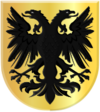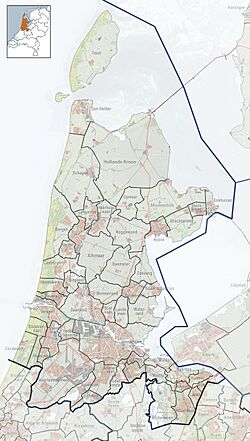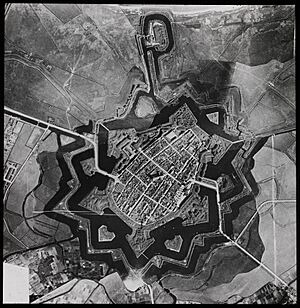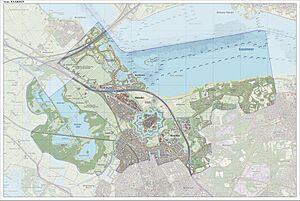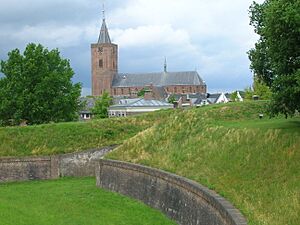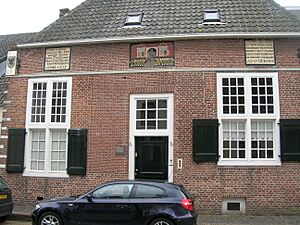Naarden facts for kids
Quick facts for kids
Naarden
|
|||
|---|---|---|---|
|
City
|
|||
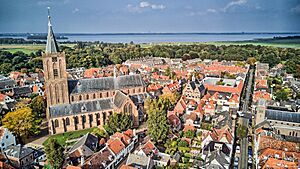
Aerial view of the historic city of Naarden
|
|||
|
|||
| Country | Netherlands | ||
| Province | North Holland | ||
| Municipality | Gooise Meren | ||
| Elevation | 3 m (10 ft) | ||
| Population
(2021)
|
|||
| • Total | 17,555 | ||
| Demonym(s) | Naardenees, Naardenaar | ||
| Time zone | UTC+1 (CET) | ||
| • Summer (DST) | UTC+2 (CEST) | ||
| Postcode |
1410–1414
|
||
| Area code | 035 | ||
Naarden is a historic city located in the North Holland province of the Netherlands. It used to be its own town, but since 2016, it has been part of a larger area called Gooise Meren. Naarden is famous for its unique star-shaped design and old fortifications.
Contents
Exploring Naarden's Past
Naarden received its special "city rights" in the year 1300. This meant it had certain freedoms and rules, making it an important town in the Gooi region. Over time, it grew into a strong, fortified town with a busy textile industry.
The 1572 Attack on Naarden
In 1572, a sad event happened in Naarden. Spanish soldiers attacked the city as part of a conflict against Dutch rebels. The city was badly damaged and burned down. Only about 60 people survived this terrible event.
This attack made the Dutch rebels even more determined to fight for their freedom. It became a key moment in the Eighty Years' War, also known as the Dutch War of Independence against Spain.
Naarden's Unique Star Shape
Naarden is a great example of a "star fort." This means it has strong, pointed walls and a moat (a deep, wide ditch filled with water) all around it. These features were designed to protect the city from attacks.
The walls and moat have been repaired many times throughout history. One major restoration happened when the French controlled the area between 1795 and 1814.
The Siege of Naarden (1813–1814)
After a big battle called the Battle of Leipzig in 1813, the Netherlands was freed by armies from different countries. However, Naarden was under siege for several months. The French commander inside the city didn't believe that Napoleon had been captured.
Finally, in May 1814, the French soldiers left the city. They were allowed to retreat with honor, meaning they could leave peacefully.
Famous People and Changing Times
John Amos Comenius, a famous educator from the 17th century, is buried in Naarden. He was from the Czech Republic. His tomb is open for visitors to see.
Even though Naarden was very important long ago, its population was later passed by nearby Hilversum. Today, Naarden is smaller than its neighbor, Bussum.
Naarden's unique shape was also helpful during World War II. Pilots returning to England after bombing raids on Germany used it as a landmark to guide them home.
Becoming Part of Gooise Meren
Naarden was its own separate municipality (a type of local government area) until 2015. On January 1, 2016, Naarden joined with two other towns, Muiden and Bussum, to form the new municipality of Gooise Meren.
Economy and Business
The company Stork B.V. used to have its main office in Naarden.
Naarden's Location
The city of Naarden is found in the Gooise Meren municipality, which is in the western part of the Netherlands. It is located in the Gooi region, in the southeast of the North Holland province.
What to See and Do in Naarden
Naarden has many interesting places to visit. It is home to the Dutch Fortress Museum (Nederlands Vestingmuseum), where you can learn all about old forts.
Every two years, Naarden hosts a special Photo Festival. Also, on Good Friday, a famous musical performance called Bach's St. Matthew Passion is held in the local church.
The Great Church
The Great Church (Grote Kerk) on Marktstraat was built in the 15th century. Before the Protestant Reformation, it was known as St. Vitus Church. It is one of the oldest churches still standing in the Netherlands. It was lucky to survive the Spanish invasion of 1572 when much of the town was burned.
Inside, the church has many wooden ceilings painted with scenes from the Old and New Testaments. These paintings were hidden for many years and were only found again during a recent restoration. The church is now used for cultural events, like organ music concerts and the Naarden Photo Festival.
The Spanish House
The Spanish House (Spaanse Huis) is located at Turfpoortstraat 27. It was originally a church building. In 1572, about 700 townspeople gathered there to hear a peace offer from the Spanish troops. Instead, the Spanish soldiers attacked them and then set the town on fire. A special plaque above the door remembers this terrible event.
In 1615, after the town was rebuilt, the city hall was built on this spot. Part of the building was used as "De Waag" (The Scales House), where weights and measures were checked. Later, a French army used it as a bakery, making over 1000 loaves of bread a day! From 1967 to 1992, it was the Comenius museum. Today, this historic building is the Weegschaal Museum.
Comenius Mausoleum
John Amos Comenius is buried in a special tomb called a mausoleum on Kloosterstraat. Many visitors come from the Czech Republic, where he was born. Comenius is famous for creating our modern school system, with different grades and classes.
Getting Around Naarden
The closest train station is Naarden-Bussum railway station. From there, you can catch trains to cities like Almere, Amersfoort, Amsterdam, and Utrecht.
Well-Known People from Naarden
Many interesting people have lived in Naarden, including:
- Nordin Amrabat (born 1987), a football player
- Willem Arondeus (1894–1943), an artist, author, and member of the Dutch Resistance during World War II
- Tim Coronel (born 1972), a racing driver
- Tom Coronel (born 1972), also a racing driver
- Maarten de Bruijn (born 1965), a product designer
- Annemarie Groen (born 1955), a backstroke swimmer
- Egbert Haverkamp-Begemann (1923–2017), an art historian
- Tom van 't Hek (born 1958), a field hockey player and coach
- Frank Martin (1890–1974), a Swiss composer who lived in Naarden from 1954
- Bertil Schmüll (born 1946), an engraver
- Salomon van Ruysdael (~1602–1670), a painter
- Jip Janssen (born 1997), an Olympic gold medal-winning field hockey player
See also
 In Spanish: Naarden para niños
In Spanish: Naarden para niños



